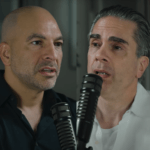Following last weekend’s email discussing the recent psilocybin trial for depression, there has been a lot of curiosity about the continued developments in the psychedelic therapy space. To that end, I wanted to discuss the most recent study of 3,4-Methylenedioxymethamphetamine (MDMA)-assisted therapy for post-traumatic stress disorder (PTSD). The trial signals an exciting step forward for the trailblazing treatment, galvanized by psychedelic pioneer researcher Rick Doblin. In my conversation with Rick in 2019, he shared his long road to achieve FDA approval for the PTSD treatment, and I remain in awe of his unparalleled ability to play the long game to realize his vision.
The most recent study of MDMA-assisted therapy for PTSD coming out of the Multidisciplinary Association For Psychedelic Studies (MAPS) demonstrated safety and significantly improved participant PTSD severity and functional impairment compared to the placebo with therapy treatment. The positive results of this study means that MDMA-assisted therapy treatment is halfway to FDA-approval for therapeutic use for PTSD, which requires two positive phase 3 trials. There is currently a second phase 3 trial underway in the recruitment stage and is expected to finish in 2023. For the time being, the alternative treatment remains an FDA-designated breakthrough therapy, which means it is on a fast track for experimental research and approval.
Unlike psilocybin, which we discussed last week, MDMA is not psychoactive—that is, it does not produce any hallucinations. However, it does produce a very noticeable increase in empathy, hence its descriptor as an “empathogen,” which is quite unmistakable to most. It’s this profound increase in empathy that almost assuredly plays a role in the efficacy of MDMA for aiding in the repair of trauma. To give you a sense of how MDMA is used clinically, and what the patients experience, this short (9 minute) video is a great overview.
As far as studies go, this MAPS-designed study in partnership with the FDA met the gold standard for evaluating an alternative treatment’s efficacy: the randomized, double-blind (as much as such a study can be blinded to the patient; more on that below), placebo-control study (spanning 15 study sites in the U.S., Canada, and Israel) assigned about half of the 90 participants to either MDMA-assisted therapy or inactive placebo with therapy. Every 4 weeks, both treatment groups received three 8 hour sessions of MDMA-assisted therapy or placebo with therapy treatment. The dose started at 80 mg with a booster in the first session, then increased for the remaining 2 sessions to 120 mg with a booster. Additionally, participants had weekly 90 minute therapeutic integration sessions (9 in total) to process the preceding experiences.
To evaluate the safety and efficacy of MDMA itself, the study chose to use an inactive placebo with therapy as a comparison treatment. Given the subjective effects of MDMA, the choice was likely at the cost of participant blinding (the study reports that about 10% of participants inaccurately guessed which treatment they had received). In contrast, previous phase 2 studies used a lower dose of MDMA, which improved blinding but led to a smaller effect between the groups. The phase 3 trial design protected the outcome data integrity (despite potential unblinding) by having site therapists collect treatment safety data (by necessity) and independent raters assess PTSD severity and functional impairment data, to avoid bias.
The study evaluated PTSD severity using a diagnostic interview assessment called a clinician-Administered PTSD Scale for DSM-5 (CAPS-5) that uses criteria such as rates of intrusive symptoms, symptom durations, and degree of: avoidance moods, arousal, dissociation, and distress. The study also evaluated functional impairment (in work, school, and personal life) as a secondary outcome, using a Sheehan Disability Scale (SDS). For each treatment arm in the study, mean scores of both the CAPS-5 and SDS evaluations were compared after about 4 months of treatment. On average, the MDMA-assisted treatment had a PTSD severity score reduction that was 11.9 points more than the placebo with therapy treatment group (the group mean score reduction was 24.4 points in the MDMA with therapy treatment group and was 13.9 points in the placebo with therapy treatment group). The study also reported a significant reduction in functional impairment between treatment groups, with an average 3.1 point SDS score reduction in the MDMA-assisted therapy treatment group compared to a 2 point reduction in the placebo with therapy treatment group. At the time of the final evaluation 18 weeks after the trial began, more participants in the MDMA-assisted therapy treatment group compared to the placebo with therapy treatment group no longer met the DSM-5 criteria for PTSD (67% vs 32%) and more participants in the experimental treatment group had PTSD remission (33% vs 5.4%; remission defined as a decrease of at least 10 points on the CAPS-5 from baseline score).
The trial also looked at the safety of MDMA-assisted therapy by comparing adverse events to placebo. These included suicide attempts or hospitalization for suicide ideation and issues related to self-harm and cardiac events. There was no significant difference in safety between the two treatment groups and notably, there were no cardiac issues in the MDMA-assisted therapy treatment group (which is known to increase heart rate and blood pressure).
Importantly, MDMA-assisted therapy requires a smaller minimal effective dose to effectively treat PTSD compared to longer psychotherapy treatments or antidepressant treatments that require daily dosing. The treatment alternative will not only change the course of clinical treatment for people suffering from PTSD, but it will also change the psychiatric field. A psychiatrist’s recent op-ed in Wired reflected how the psychopharmacology field has long been tasked with repairing “chemical imbalances” in patients with PTSD, which in turn detracts from the therapist-client relationship and in many instances, never adequately treats the illness (current FDA-approved antidepressant treatments for PTSD include paroxetine and sertraline, also known as Paxil and Zoloft, which have a 40-60% response rate and are not as safe or effective as MDMA-assisted therapy). With MDMA-assisted therapy, therapists can relate to the patient differently: not as someone who requires a prescription but rather as someone to support in therapeutic sessions while they work through previous trauma experiences.
***
Please note we will not release a podcast tomorrow due to Memorial Day. Enjoy the week to catch up!





